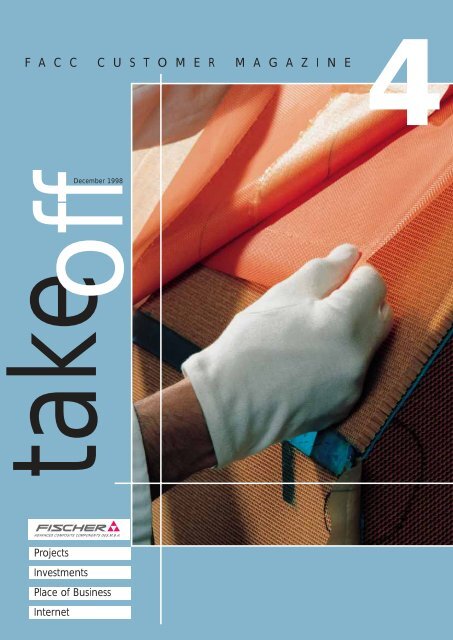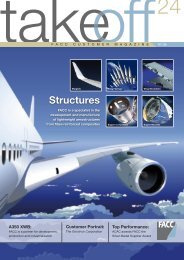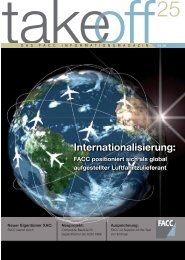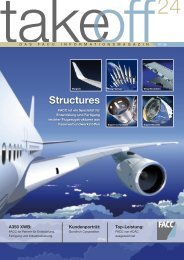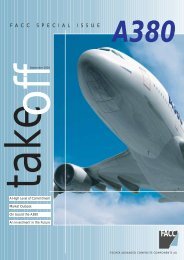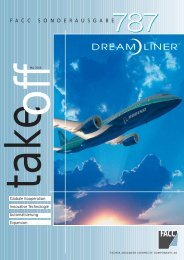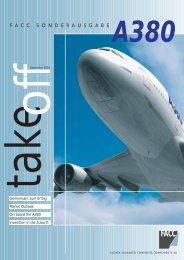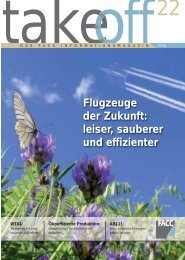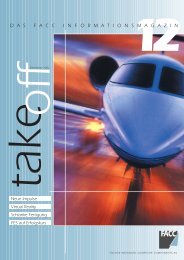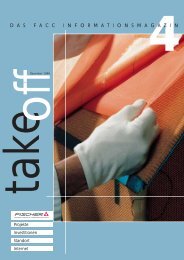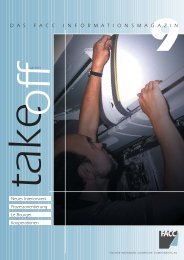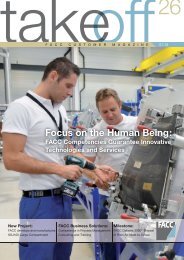Create successful ePaper yourself
Turn your PDF publications into a flip-book with our unique Google optimized e-Paper software.
F A C C C U S T O M E R M A G A Z I N E<br />
<strong>take</strong> off<br />
Projects<br />
Investments<br />
Place of Business<br />
Internet<br />
December 1998<br />
4
F A C C C U S T O M E R M A G A Z I N E<br />
Dear readers,<br />
<strong>take</strong>off2<br />
<strong>take</strong> off<br />
Off we go into the Internet.<br />
Work is proceeding full steam ahead to<br />
complete a new form of access to <strong>FACC</strong> and,<br />
starting 1 February 1999, you can visit our<br />
website at this address - www.facc.co.at. The<br />
specialists at interact!multimedia have come up<br />
with the technical and graphic design in<br />
cooperation with our experienced <strong>take</strong> off<br />
graphic artist, Mr. Pointecker. The website is to<br />
complement <strong>take</strong> off wherever it makes sense.<br />
More on page 14.<br />
Back to <strong>take</strong> off and to what you can expect in<br />
the fourth issue. While the previous issue of<br />
<strong>take</strong> off featured articles on Boeing and Airbus<br />
Industrie, this issue will contain a report about<br />
the current market situation and new<br />
developments concerning the 30 to 100<br />
passenger jetliners. We would like to thank<br />
Mr. Carl Albert, CEO of Fairchild Aerospace for<br />
his article.<br />
It must also be mentioned that <strong>FACC</strong> has <strong>take</strong>n<br />
on part of the R&D for Airbus Industrie´s new<br />
aircraft, the A 340-500/600. This is a milestone<br />
inasmuch as we have now joined the ranks of a<br />
systems supplier not only for Boeing but also for<br />
DASA.<br />
In addition to information on new projects and<br />
investments we should like to give you some<br />
insight into the surrounding area of our<br />
company location. After all, it is great to be able<br />
to work in a country where others vacation.<br />
We shall be featuring Upper Austria in its<br />
importance as a place of industry and as a<br />
favorite vacation spot in the heart of the<br />
European Union.<br />
Happy holidays!<br />
Andrea Schachinger / Manfred Neuböck<br />
Editors<br />
Contents:<br />
Building the future 3<br />
Innovative <strong>FACC</strong>-Design<br />
For The New A340-500/-600 4<br />
Expansion and Investments 7<br />
First Flight of the Boeing 717-200 8<br />
Fairchild<br />
Aerospace 10<br />
Upper Austia 12<br />
@<br />
<strong>FACC</strong> Goes Cyber 14<br />
Innovation from<br />
Austria 15<br />
Published by: FISCHER ADVANCED COMPOSITE COMPONENTS GES.M.B.H., Fischerstraße 9,<br />
A-4910 Ried/Austria. Editorial Staff: Andrea Schachinger, Manfred Neuböck, Walter Stephan.<br />
Photos: Alois Furtner Reportagen,Ried, Lang & Lang Klagenfurt, Austrian Airlines Wien,<br />
Boeing Seattle, Airbus Industrie Toulouse, Fairchild Aerospace, San Antonio. Design and<br />
Composition: Oskar Pointecker „Ihr Druckpartner”, 4941 Mehrnbach.
F A C C C U S T O M E R M A G A Z I N E<br />
Building<br />
the future<br />
In the last issue of <strong>take</strong> off I presented<br />
our view on the development of the<br />
aviation industry in the next few years.<br />
The article also featured the ways and<br />
means we will have to resort to if we<br />
are to master stormy weather together<br />
with our customers, suppliers and<br />
employees while maintaining continuous<br />
growth. Barely half a year has passed<br />
since then and we are already in the<br />
middle of actively implementing these<br />
ways and means: Every day we inch<br />
forward towards making the long-term<br />
planning become reality, every day we<br />
fine-tune the concept to fit everyday<br />
requirements, and all this without<br />
losing sight of the overall strategic goal.<br />
Milestones of the last few<br />
months:<br />
● Two years of intensive product<br />
development to the tune of an investment<br />
volume of US$ 8 mil was concluded<br />
in November to everyone’s satisfaction<br />
– the first complete passenger cabin<br />
developed by <strong>FACC</strong> was installed<br />
successfully into a B717. Thanks to our<br />
know-how and a number of innovative<br />
ideas we have succeeded in achieving<br />
a significant reduction not only in<br />
weight, but also in installation time.<br />
Major competitive advantages of the<br />
B717 such as low operating costs, low<br />
fuel consumption and high passenger<br />
comfort in the 100-seater market are<br />
profound reasons to expect high<br />
production rates. By re-structuring its<br />
program management – the changes<br />
will be implemented within the first<br />
quarter 1999 – <strong>FACC</strong> will have the<br />
adequate tools to cope with the<br />
comprehensive challenges in the field<br />
of logistics and of catering to the<br />
configuration needs of the individual<br />
airlines. Small efficient offices right at<br />
the Boeing homebase, a repair station<br />
in Long Beach as well as the permanent<br />
presence of <strong>FACC</strong> representatives at the<br />
most important sub-suppliers for the<br />
interior will guarantee the excellent<br />
quality and delivery performance we<br />
are noted for.<br />
● Two important contracts for<br />
developing and supplying components<br />
for the new generation of the A340<br />
aircraft, the A340-500 and –600 have<br />
been signed with DaimlerChrysler<br />
Aerospace Airbus and Hispano Suiza<br />
Aerostructures. For these long-term<br />
development projects, <strong>FACC</strong> will be<br />
responsible for the component<br />
definition and development of the<br />
blocker doors and of spoilers 2 and 6.<br />
This will require intensive cooperation<br />
with our clients and a permanent and<br />
rapid exchange of data and information<br />
if we are to achieve time-saving<br />
procedures and swift progress in the<br />
project work. Once again <strong>FACC</strong> will<br />
bank on proximity to our customers.<br />
Our engineers are working on concurrent<br />
engineering teams in Le Havre and<br />
Bremen. Apart from our profound<br />
technological background, these<br />
integrative engineering concepts and<br />
our approach to team-oriented<br />
engineering in close cooperation with<br />
the customer are the elements that<br />
have paved the way for <strong>FACC</strong> to move<br />
up into the ranks of a systems supplier<br />
also in the field of structural elements.<br />
New orders and a higher turnover<br />
require capacity adjustments:<br />
Only recently we have completed the<br />
final stages of our office complex<br />
creating workspace for the engineering,<br />
sales and shipping departments. The<br />
growing number of employees requires<br />
a structural adaptation to ensure our<br />
efficiency and customer orientation.<br />
This is why we have created separate<br />
positions for the product management<br />
of cabin interior and structural components.<br />
On a medium-term range we<br />
are also planning a separation of the<br />
areas of the production facilities.<br />
In order to achieve our set goal<br />
of a turnover of ATS 1.2 billion<br />
(EURO 87 mil/US$ 102 mil) these<br />
are small steps. Our future editions<br />
of <strong>take</strong> off will keep you posted<br />
on the strategic measures that<br />
lie ahead.<br />
Walter A. Stephan<br />
Chief Executive Officer<br />
3 <strong>take</strong>off
F A C C C U S T O M E R M A G A Z I N E<br />
Fairchild<br />
Aerospace<br />
Fairchild Aerospace: A German-American Company on the Move<br />
Carl Albert<br />
Chairman/Chief Executive Officer<br />
Fairchild Aerospace Chairman and<br />
Chief Executive Officer Carl A. Albert<br />
acquired Fairchild Aircraft in 1990.<br />
Prior to his acquisition, Albert provided<br />
venture capital to Wings West Airlines,<br />
a California regional commuter airline,<br />
formed in 1981.<br />
Albert’s business experience includes<br />
15 years as an attorney, specializing<br />
in business and corporate law in Los<br />
Angeles, California, from 1967<br />
through 1981. He also has served as<br />
a member of the board of directors<br />
of several publicly held and private<br />
corporations.<br />
The histories of Fairchild Aerospace,<br />
Fairchild Aircraft and Dornier Luftfahrt<br />
GmbH have involved revolutionary<br />
changes to meet the demands of the<br />
growing aircraft industry through the<br />
years.<br />
Fairchild Aerospace Corporation took<br />
flight in June 1996, when Fairchild<br />
Aircraft of San Antonio, Texas, USA<br />
acquired Dornier Luftfahrt GmbH of<br />
Oberpfaffenhofen, near Munich,<br />
Germany. Since the day these two<br />
<strong>take</strong>off10<br />
companies joined forces, Fairchild<br />
Aerospace has cut costs and increased<br />
sales and profits.<br />
With the dedication of a dynamic<br />
management team and a highly qualified<br />
and enthusiastic workforce,<br />
Fairchild Aerospace has strengthened<br />
its balance sheet and introduced a<br />
pace-setting product line that responds<br />
precisely to the growing requirements<br />
and preferences of airlines, corporate<br />
customers and passengers worldwide.<br />
Fairchild Aircraft began manufacturing<br />
the Metroliner aircraft in the 1970s. The<br />
Metro is a small, 19-seat turboprop that<br />
played a major role in the first years<br />
after deregulation. During that time, the<br />
Metro replaced unpressurized, 15- to<br />
17-seat airplanes, creating the basis<br />
upon which some of today’s most<br />
profitable and successful regional<br />
airlines started.<br />
Dornier Luftfahrt GmbH was formed in<br />
1922 by the late Professor Claude<br />
Dornier. The Dornier company has<br />
been recognized as an aviation pioneer<br />
and a leader in aircraft manufacturing,<br />
service and support for more than<br />
75 years.<br />
Dornier introduced the Flying Boat, its<br />
first aircraft, in 1922. Acquired by<br />
Daimler Benz in 1985, the company<br />
invested $1 billion in the development<br />
of the dornier 328 turboprop. Though<br />
it was one of the most quiet and fast<br />
turboprops in the world, the aircraft<br />
came too late to a market already<br />
saturated with turboprop aircraft, and to<br />
a market that was fast losing interest in<br />
anything but jets.<br />
Carl Albert knew<br />
that the Dornier 328 turboprob<br />
was the best turboprop in its class.<br />
It was a well-engineered, spacious<br />
aircraft. However, he knew the market<br />
was changing. Albert concluded that by<br />
converting the 328 turboprop to a<br />
jet would revolutionize the market.<br />
Thus came the birth of the 328JET, the<br />
first regional aircraft in the 32- to<br />
34-seat jet market, a program that was<br />
accomplished in a little over a year’s<br />
time and for a cost of less than $100<br />
million.<br />
Fairchild Aerospace launched the<br />
328JET program with the vision to<br />
identify future market trends and<br />
resources to support development.<br />
In February 1997, the company<br />
announced that the jet would roll out<br />
on December 6, 1997 and make its<br />
first flight January 20, 1998. Fairchild<br />
achieved both milestones. Currently in<br />
flight test, the 328JET will enter airline<br />
service in the spring of 1999.<br />
The 328JET will be the first regional jet<br />
in the 30-seat jet class. The company<br />
estimates that operators worldwide will
F A C C C U S T O M E R M A G A Z I N E<br />
provide an<br />
additional 10 seats and<br />
low incremental operating cost<br />
to make it a logical addition to airline<br />
fleets with a family of aircraft in the 32to<br />
42-seat size category.<br />
In addition to the 328JET and 428JET,<br />
Fairchild Aerospace is creating the<br />
528JET, 728JET and 928JET aircraft.<br />
This production of an all-new,<br />
wide-body, low-wing aircraft, starting<br />
with the 70-seat 728JET, will set the<br />
standard for comfort in the industry.<br />
Most importantly, high commonality<br />
between the 55-seat 528JET, the<br />
70- to 75 seat 728JET and the 90- to<br />
95-seat 928JET will reduce operating<br />
costs of the airlines that operate this<br />
family of aircraft. The 728JET family is<br />
believed to be the aircraft that will<br />
change the industry.<br />
Development of the 428JET, 528JET,<br />
728JET has already begun. These<br />
large-cabin aircraft are hailed as the first<br />
true regional jets in their seat categories<br />
ranging from 44 to 98 seats.<br />
Today, the company is investing more<br />
than $1 million per month in research<br />
and development for its regional<br />
airliner program. Total program cost,<br />
with risk-sharing partners, will run<br />
approximately $850 million.<br />
"We intend to invest a billion dollars in<br />
this 728 family, including research and<br />
development, tooling and working<br />
capital," said Albert.<br />
Fairchild Aerospace also has entered<br />
the business aircraft market with the<br />
Envoy 3, 4 and 7, which offer the<br />
industry’s most spacious cabins for the<br />
price. These business jets bring an<br />
unprecedented level of reliability to the<br />
fast-paced corporate market. Precise<br />
German engineering will enable the<br />
Envoy 3 and Envoy 4 to outshine their<br />
rivals.<br />
Entering service in 1999, the Envoy 3 is<br />
truly revolutionary. It offers the<br />
cabin comfort of large jets and the<br />
economics of mid-size jets. The Envoy<br />
4 will enter service in 2001, providing<br />
its travelers with the advantage of the<br />
Envoy 3, with an 11-foot longer cabin.<br />
Fairchild Aerospace’s latest response to<br />
needs of the corporate market is the<br />
visionary Envoy 5, 7 and 9 family. The<br />
first of the family to enter service in<br />
2001 will be the Envoy 7, offering vast<br />
cabin space, superior performance and<br />
low operating costs. The Envoy 5 will<br />
enter the market in 2002 as the most<br />
modern aircraft with the lowest<br />
acquisition and widest cabin for its<br />
price. The Envoy 9 is scheduled to<br />
enter service in 2003, designed to be<br />
the roomiest and most affordable<br />
business jet ever created.<br />
Fairchild Aerospace is the only aircraft<br />
manufacturer that comprises an equal<br />
partnership of American management<br />
and German engineering and<br />
manufacturing expertise, with independent<br />
assembly facilities on both sides<br />
of the Atlantic. Manufacturing of all<br />
aircraft, except for wing assembly,<br />
will be accomplished at the<br />
Oberpfaffenhofen facilities near<br />
Munich, Germany.<br />
"German engineering is synonymous<br />
with quality," said Albert. "I <strong>take</strong> a great<br />
deal of comfort from the fact that<br />
German engineers are designing our<br />
aircraft. They are the best engineers in<br />
the world, and they will do their work in<br />
an efficient manner.<br />
Since the acquisition of Fairchild Aircraft<br />
in 1990, and Dornier Luftfahrt GmbH<br />
Dornier is a valued customer of<br />
<strong>FACC</strong> for many years. Following<br />
components are manufactured<br />
by <strong>FACC</strong> and supplied to the<br />
Do328 line:<br />
- Cargo compartment liners<br />
- Cockpit-liners<br />
- Toilet<br />
in 1996, Fairchild Aerospace has<br />
created jobs in both the United States<br />
and Germany. Compared to the 150<br />
people employed within the company<br />
when Carl Albert acquired it in 1990.<br />
Fairchild Aerospace now employs<br />
approximately 2,800 personnel<br />
worldwide, with nearly 2,000 residing<br />
in Germany and more than 800<br />
residing in the United States.<br />
"When our new family of aircraft<br />
is in production, our employment<br />
will increase to more than 4,000,"<br />
added Albert.<br />
11 <strong>take</strong>off
F A C C C U S T O M E R M A G A Z I N E<br />
Innovative <strong>FACC</strong>-Design<br />
For The New A340-500/-600<br />
Peter Diesch of DaimlerChrysler Aerospace Airbus signed a 250 mil ATS contract in<br />
Hamburg with Ried´s high-tech company. <strong>FACC</strong> will be developing and supplying<br />
structural components for the wings of the new flagships of Airbus´s four-engine<br />
fleet, the A340-500 and the A340-600.<br />
The A340-500 can carry its 313<br />
passengers 15,750 km (8,500 naut. mi.)<br />
– the longest range of any commercial<br />
aircraft. The bigger sister in the A340<br />
family is capable of transporting 380<br />
passengers over 13,900km (7,500<br />
naut. mi.).<br />
This ultra-long-range capability makes<br />
these two new aircraft models cut right<br />
out for new destination-to-destination<br />
trips especially in the Pacific region.<br />
According to Boeing´s forecast for<br />
1998 - 2017 this is a market segment,<br />
which – due to the Asian economic<br />
turmoil – is going to shrink in the next<br />
few years but will be the fastest<br />
growing segment after 2002.<br />
By 2010 Airbus anticipates an overall<br />
market of 1500 long-range 300-400<br />
long-range seaters, which will be<br />
divided up between the A340 and<br />
Boeing 777/747.<br />
In 2002 the first jetliners will be<br />
delivered to the airlines and the first<br />
passengers will have the pleasure of<br />
being whisked away by the new planes.<br />
<strong>FACC</strong> will develop and produce Spoiler<br />
2 and Spoiler 6 for the wings of both of<br />
<strong>take</strong>off4<br />
these models. These spoilers serve as<br />
lift dumps which reduce the lifting<br />
force caused by the wing. In certain<br />
flight situations they <strong>take</strong> over the<br />
function of the aileron, regulate the<br />
rate of descent, prevent up float after<br />
landing and act as an additional air<br />
brake, thus helping to decelerate the<br />
plane after landing.<br />
Spoiler 2:<br />
Important for the airworthiness<br />
Spoiler 2 is a particularly important<br />
component for the airworthiness of<br />
a plane. If it fails and damages the<br />
horizontal tail it can render the plane<br />
unmanoeuverable. Such emergency<br />
situations caused by the loss of the<br />
component will be prevented by using<br />
special fail-safe fixtures.<br />
The amount of stress the composite<br />
spoilers and the integrated metal<br />
fixtures for mounting and adjusting<br />
components is enormous: for aerodynamic<br />
reasons the thin trailing edges<br />
of the spoiler need to be firmly integrated<br />
with the surrounding wing elements<br />
during <strong>take</strong>-off and flight, at all speeds<br />
and during all plane manoeuvres.<br />
Accordingly, the tests are comprehensive<br />
and strict: static tests are performed<br />
with 50% extra stress added to the<br />
maximum in-flight stress. That amounts<br />
to more than two tons per spoiler<br />
(which corresponds to the weight of<br />
two mid-size cars). In addition, we<br />
must prove that damage through rock<br />
impact will not cause the spoiler to fail.<br />
<strong>FACC</strong> is also required to carry out dynamic<br />
tests simulating the entire life-span of<br />
an aircraft, hence they have also become<br />
part of our testing routine.<br />
The tough criteria: 100,000 flight<br />
hours, 10 years, 20,000 flights. To<br />
demonstrate adequate service<br />
life, fatigue, damage tolerance<br />
and residual strength tests have<br />
do be performed.
F A C C C U S T O M E R M A G A Z I N E<br />
All spoilers activated after landing<br />
Three additional planes containing components<br />
provided free by <strong>FACC</strong> will be<br />
used as test aircraft for the qualification<br />
procedure. These test planes are<br />
subjected to 4000 hours of testing<br />
under all sorts of conditions, assuming<br />
every imaginable pilot error.<br />
Taking on systems responsibility<br />
for structural components<br />
Closing this deal is the ultimate reward<br />
for long-range planning and preparation<br />
at <strong>FACC</strong>. Already in 1996 the company<br />
added large-scale assembling facilities<br />
in order to be able to manufacture<br />
Closing the deal : Peter Diesch (DASA) and Walter Stephan sign the<br />
"milestone" contract.<br />
ready-to-use composite components like<br />
the spoilers. For two years <strong>FACC</strong> had<br />
consistently tried to establish itself as a<br />
partner in this field especially with Airbus.<br />
This was not the only reason, however,<br />
why Walter A Stephan, CEO at <strong>FACC</strong>, calls<br />
the contract a milestone for the company:<br />
"We are already a systems supplier for<br />
aircraft interiors. For example, we have<br />
developed and produced the passenger<br />
cabin for the Boeing 717 short-range<br />
aircraft including an installation system for<br />
lighting, ventilation, passenger comfort<br />
and emergency equipment. We are<br />
striving to obtain a similar position with<br />
structural components. This Airbus<br />
contract now for the first time makes us<br />
a player in the field of systems responsibility<br />
for structural components."<br />
Up-to-date information on the new<br />
Airbus aircraft as well as a video clip<br />
on the new four-engine 340 series<br />
can be found on the Airbus<br />
homepage: www.airbus.com<br />
5 <strong>take</strong>off
F A C C C U S T O M E R M A G A Z I N E<br />
Spoilers contribute to bringing a plane<br />
to a halt faster after landing<br />
Just like with the cabin interior project for<br />
Boeing, <strong>FACC</strong> was already involved in the<br />
project when it was in the developing<br />
stage – when the industrial program<br />
start was announced in December 1997.<br />
"Move closer to the customer" is the<br />
motto. Since October, up to four of our<br />
employees from Ried have been stationed<br />
with DaimlerChrysler Aerospace Airbus in<br />
Bremen. They will be spending quite a bit<br />
of time in the town that was put on the<br />
map of aviation pioneers thanks to the<br />
daring flight experiments and construction<br />
concepts of engineers Henrich Focke and<br />
Georg Wulf at the turn of the century.<br />
According to Focke, his contemporaries<br />
saw his daring under-takings as "a spooky<br />
atmosphere of adventure, circus, insane<br />
asylum and graveyard", which has since<br />
developed into the Bremen aircraft<br />
industry. This prodigy has meanwhile left<br />
the boundaries of our planet´s atmosphere<br />
and is involved with space projects.<br />
DaimlerChrysler Aerospace Airbus in<br />
Bremen also operates the joint computer<br />
calculations model that is being permanently<br />
fed all the current data submitted by all the<br />
suppliers for the new aircraft models.<br />
State-of-the-art communications technology<br />
makes the permanent exchange of information<br />
possible und enables us to use<br />
CAD data fresh from a computer in<br />
Bremen in the production planning for the<br />
corresponding components in Ried just a<br />
few hours later.<br />
Due to the new project the <strong>FACC</strong><br />
headquarters in Ried have increased their<br />
staff and recruited two new employees for<br />
the stress engineering department .<br />
<strong>take</strong>off6<br />
From a mere supplier to a<br />
risk-sharing partner<br />
Walter A. Stephan: "In this project we are<br />
not merely a supplier but a risk-sharing<br />
partner. Within the framework of our<br />
contract we shall be financing ATS 50 mil<br />
in developing and tool costs."<br />
Closer<br />
to the customer<br />
The time frame for the project: The first<br />
components are delivered in the fourth<br />
quarter of 1999. In 2001 the first plane<br />
of the new generation with an MTOW<br />
(maximum <strong>take</strong>-off weight) of 365 tons<br />
will lift off the runway. In 2002 the new<br />
planes will carry their first passengers.<br />
The original Bremen Musicians<br />
according to Grimm´s Tales and the <strong>FACC</strong> "Musicians" Dieter Lapusch, Kurt Pieringer,<br />
Wolfgang Billinger, Harald Mittermaier – part of the DASA engineering team in<br />
Bremen since 19 October 1998<br />
The long-distance carriers of the near future:<br />
A340-500 A340-600<br />
wing span: 63,5 m 63,5 m<br />
lenght: 67,5 m 74,9 m<br />
height: 17,7 m 17,7 m<br />
number of seats: 313 380<br />
range: 15.750 km 13.900 km
F A C C C U S T O M E R M A G A Z I N E<br />
Expansion<br />
and Investments<br />
Full order books, solid financial growth<br />
in recent years and a rosy forecast for<br />
the growing aviation market – these are<br />
only some of the factors that have<br />
motivated the <strong>FACC</strong> management to<br />
provide the necessary basis for further<br />
positive future development of the<br />
company. The motto is expansion and<br />
investment.<br />
Expansion of our<br />
office building<br />
A mere 18 months after completion,<br />
the continuing growth of <strong>FACC</strong> has<br />
made it necessary to add on to our<br />
office building. About 5 mil. ATS were<br />
invested to create 21 new office<br />
spaces. These new offices are mainly<br />
reserved for employees working in<br />
sales and technology. A new conference<br />
room was also added.<br />
Since we cooperated with the same<br />
companies as in the past the project<br />
was completed in a mere ten weeks<br />
and the offices could be moved into at<br />
the beginning of November.<br />
Expansion of the <strong>FACC</strong><br />
office space.<br />
Office space before November 1998:<br />
15,600 sq.ft/1,450 m 2<br />
Office space as of November 1998:<br />
19,000 sq.ft/1,800 m 2<br />
New 5-axis processing center Jobs<br />
Jomach 32:<br />
Just before Christmas the third 5-axis<br />
processing center at <strong>FACC</strong> – a Jobs<br />
Jomach 32 – was delivered and set up.<br />
It will go into operation at the<br />
beginning of January 1999. The new<br />
center will be used primarily for working<br />
on overhead stowage bins for Airbus<br />
A319/A320/321, but also for the new<br />
Boeing B717-200. It is mainly reserved<br />
for carrying out various drilling and<br />
milling work.<br />
In addition to its main use this machine<br />
has universal applications.<br />
It represents an investment value of<br />
approximately 7.5 mil. ATS.<br />
<strong>FACC</strong> currently has three modern 5-axis processing<br />
centers supporting the automatic processing of<br />
components.<br />
Workrange Axis<br />
x-axis y-axis z-axis<br />
Jomach 23: 5,2m/17,1ft 2,2m/7,2ft 1,2m/3,9ft<br />
Jomach 146: 9,8m/32ft 4,0m/13,1ft 2,0m/6,6ft<br />
Jomach 32: 4,0m/13,1ft 2,0m/6,6ft 1,5m/4,9ft<br />
7 <strong>take</strong>off
F A C C C U S T O M E R M A G A Z I N E<br />
First Flight<br />
of the Boeing 717-200<br />
Long Beach, California, 2 September 1998 – The 717-200, Boeing’s newest<br />
100-seat jetliner, sets out on her first flight. A jubilant crowd of spectators – Boeing<br />
employees as well as delegations of clients and suppliers – watch the impressive<br />
performance as the short-range jet <strong>take</strong>s off to the skies with ease.<br />
This maiden flight lasted four hours and<br />
seven minutes and ended at the<br />
Boeing test center in Yuma, Arizona,<br />
home base for the first B717-200 for<br />
the next ten months. For the first time<br />
the plane proved its airworthiness with<br />
a series of in-flight tests performed<br />
on the engines, the autopilot and the<br />
flight management system. The aircraft<br />
reached a maximum altitude of 11,500<br />
ft (3,500m) and a maximum speed of<br />
245knots (450km/h). All in all, the<br />
flight debut was rated an outstanding<br />
success. The words of Jim Phillips, Vice<br />
President for the B717 program, sum<br />
up this sentiment in a letter sent to<br />
<strong>FACC</strong> after the flight debut: "To a great<br />
extent we at Boeing owe the extraordinary<br />
success of the B717-200 maiden flight<br />
to your hard work and support as a<br />
member of the Boeing Supplier Team.<br />
Thank you very much for your contribution<br />
and your outstanding involvement with<br />
the B717."<br />
A modern, passenger-friendly<br />
interior developed by <strong>FACC</strong><br />
While the first three test planes (T1, T2,<br />
T3) were used for airworthiness tests<br />
<strong>take</strong>off<br />
8<br />
only, the fourth plane (P1) – the socalled<br />
customer model designed for<br />
the launch customer AirTran - will be<br />
tested with the passenger cabin interior<br />
developed by <strong>FACC</strong>. The main purpose<br />
of the P1 tests is to obtain in-flight data<br />
on the actual performance and reliability<br />
of the supply systems for air (A/C and<br />
fresh air), water and lighting as well as<br />
the lavatories and galleys. According to<br />
the Boeing plans the entire test phase<br />
is scheduled to last until May 1999,<br />
followed by parallel certification<br />
procedures through the Federal<br />
Aviation Administration (FAA) and the<br />
European JAA (Joint Airworthiness<br />
Authority).<br />
Since the middle of October <strong>FACC</strong><br />
engineers have been stationed with<br />
Boeing in Long Beach to instruct and<br />
support the Boeing staff in assembling<br />
the cabin components. Prior to this<br />
stage <strong>FACC</strong> had completed a two-year<br />
intensive design and development<br />
phase for the passenger cabin of the<br />
B717-200. The result is an aircraft<br />
interior for a 100-seater which will let<br />
passengers enjoy the comfort and extra<br />
room on short-range flights that has so<br />
far only been found on jumbo size<br />
planes. <strong>FACC</strong> developed all of the<br />
ceiling, side and floor panels as well<br />
as the stowage bins including an<br />
advanced passenger service unit. The<br />
new <strong>FACC</strong> interior will attract the<br />
customer with its improved and more<br />
efficient air conditioning and ventilation<br />
system, its newly developed cabin<br />
lighting concept as well as with<br />
the excellent acoustics. Supplying<br />
pre-mounted systems and a new type<br />
of fuselage mounting devices has resulted<br />
in a reduction of assembly time.<br />
An additional plus: The weight of the<br />
components is significantly lower.
F A C C C U S T O M E R M A G A Z I N E<br />
BMW Rolls-Royce AeroEngines<br />
and <strong>FACC</strong> Begin Cooperation<br />
BMW Rolls-Royce – a joint venture<br />
between BMW of Germany and Rolls-<br />
Royce of England – produces the new<br />
advanced BR715 high-bypass-ratio<br />
engine for the B717-200. With its thrust<br />
of 18,500 pounds at <strong>take</strong>off, the<br />
BR715 offers Boeing essential<br />
advantages in fuel consumption, fewer<br />
emissions and significantly lower noise<br />
levels than comparable engines. <strong>FACC</strong><br />
– also known for its innovative and<br />
future-oriented ideas in the field of<br />
developing and manufacturing engine<br />
components – is involved in a number<br />
of research projects aiming to reduce<br />
engine noise emission. That way the<br />
HPC Fairing<br />
company intends to make an important<br />
contribution towards creating more<br />
environment-friendly passenger planes.<br />
BRR has commissioned <strong>FACC</strong> to produce<br />
high pressure compressor fairings as<br />
well as splitter fairings – a component<br />
that is directly exposed to the airstream<br />
and which houses a number of<br />
hydraulic and air pressure lines. The<br />
main factors leading to BRR´s decision<br />
to place the order with <strong>FACC</strong> were the<br />
superior technical solutions presented<br />
by <strong>FACC</strong> and the accompanying<br />
reduction in manufacturing costs<br />
and weight of the components. The<br />
individual components will be<br />
produced in sandwich technology with<br />
carbon fiber material around a Rohacell<br />
core.<br />
Splitter Fairing<br />
A Bright Future Ahead<br />
The B717 was developed<br />
to replace the thousands<br />
of airplanes covering the<br />
short-distance sector, many<br />
of which are approaching the<br />
end of their lifespan, and to<br />
cover the future need for<br />
new planes. Both <strong>FACC</strong> and<br />
BRR draw their optimism<br />
from the rosy forecasts by<br />
Boeing officials who estimate<br />
a total need of 2,600 airplanes<br />
in the 80-100 seater category<br />
within the next twenty years.<br />
9 <strong>take</strong>off
F A C C C U S T O M E R M A G A Z I N E<br />
Upper Austria<br />
A Top European Region<br />
There are at least six good reasons for<br />
companies to invest in Upper Austria:<br />
The Best Educated and<br />
Trained People<br />
Magna founder Frank Stronach spoke<br />
about the "highly qualified specialists<br />
who manufacture highly qualified<br />
products" during his recent visit to<br />
Upper Austria. These are the deciding<br />
factors for a good business location.<br />
The intellectual capacities and skills of<br />
the people play a decisive role in<br />
international competition. In addition to<br />
the basic education provided by<br />
compulsory schools, Upper Austria has<br />
a dense network of secondary and<br />
vocational schools. This network is<br />
complemented by three specialised<br />
<strong>take</strong>off12<br />
With around 1,4 million inhabitants, Upper Austria is not a large state. But it is highly productive in<br />
economic, technological, social, cultural and ecological fields.<br />
technical colleges and the Johannes<br />
Kepler University in Linz.<br />
The Research Factor<br />
In Upper Austria, R&D isn't simply given<br />
lip service by the government. During<br />
the next five years, ATS 200 million<br />
will be spent annually to successfully<br />
lead our Federal State into the next<br />
millennium. The main focus has been<br />
centred on the expansion of networks<br />
and the forcing of modernity and<br />
speed. Moneys are flowing into<br />
concept centers for information and<br />
communications technology, material<br />
sciences, and in the field of mechatronics.<br />
Clusters are forming in the<br />
plastics, paper, and pulp branches, as<br />
well as in the auto components supply<br />
industry. Research and experience<br />
will be concentrated here in order<br />
to meet the coming challenges with<br />
effectiveness and agility.<br />
Top Speed Processing<br />
Permission processing of company<br />
plants <strong>take</strong>s place in record time in<br />
Upper Austria - between the initial<br />
application and final permission there<br />
are often only a few weeks.<br />
In doing this, Upper Austria has reacted<br />
to the demands of business, because<br />
time is an important cost factor today.<br />
Those who begin production earlier can<br />
reach the customer faster, keeping<br />
them a step ahead of the competition.
F A C C C U S T O M E R M A G A Z I N E<br />
Strong in Exports<br />
Export is the sustaining pillar of<br />
industrial activity. The development of<br />
Upper Austrian industry is clearly going<br />
upwards, thanks to those branches<br />
who are heavily involved in exports<br />
(e.g. <strong>FACC</strong>'s export quota is 98% of<br />
turnover).<br />
With a population share of 17%, Upper<br />
Austria generates 25% of all exports<br />
from the Republic of Austria.<br />
These 25% share of the total Austrian<br />
foreign trade volume gives a total of<br />
ATS 180 billions, where 65% are going<br />
into the EU countries, 16% to the rest<br />
of Europe and 17% overseas.<br />
Quality of Life<br />
Upper Austria has a lot to offer as far as<br />
landscapes and culture are concerned.<br />
A symbiosis of crystal clear lakes,<br />
healthy farm land, splashy Danube<br />
waterscapes and jagged mountain<br />
peaks. Everything Austria has to offer<br />
can be found here. Cultural treasures<br />
from the prehistoric finds of the<br />
Hallstatt Era to the avantgarde art of the<br />
world-famous Ars Electronica can be<br />
admired in the 283 museums and folk<br />
houses in Upper Austria. Athletic<br />
activities in harmony with nature and<br />
culture await you.<br />
Professor Sämann from BMW once<br />
said: "It is wonderful to work in a part<br />
of the country where others spend their<br />
holidays."<br />
In the Middle of the World<br />
Not only does the diligence and skill of<br />
the people contribute to the good<br />
economic numbers in Upper Austria.<br />
The state's geographical location is also<br />
highly preferred. Near the town<br />
Kremsmünster there is a well known<br />
inn called "Zum Baum mitten in der<br />
Welt" ("To the Tree in the middle of the<br />
World"). Perhaps this part of our state<br />
does not lie in the middle of the world,<br />
but surely in the heart of Europe.<br />
This fact has made Upper Austria a<br />
springboard to the east. These structures<br />
are not new, as these transport routes<br />
had already connected us to the old<br />
industrial nation of Czechoslovakia<br />
during the monarchy.<br />
Renowned companies like VA Tech, VA<br />
Stahl, AMAG, Plasser&Theurer, BMW<br />
Steyr, MAN-SNF, SKF, Magna-Steyr<br />
Daimler Puch, Bombardier-Rotax,<br />
Rosenbauer, MIBA, UniTech, <strong>FACC</strong>,<br />
Fischer Ski&Tennis, DSM, Hoffmann-<br />
LaRoche, Lenzing, SCA Laakirchen,<br />
Engel and Greiner, just to name a few<br />
of the firms that are successful on international<br />
markets, profiting from the<br />
favourable economic climate, the<br />
qualification and motivation of the<br />
workforce, and the ambitious expansion<br />
of the Upper Austrian technical<br />
network.<br />
No wonder more and more international<br />
companies are becoming aware<br />
of Upper Austria and examining<br />
possibilities of cooperation, settlement<br />
or relocation.<br />
The Upper Austrian State Government<br />
has created the structures for this.<br />
13 <strong>take</strong>off
F A C C C U S T O M E R M A G A Z I N E<br />
www.facc.co.at.<br />
<strong>FACC</strong> Goes Cyber<br />
In conjunction with multimedia!interact,<br />
our competent partner in Salzburg, we<br />
are currently working at a fever pitch to<br />
complete the <strong>FACC</strong> website, and plan<br />
to go online on 1 February 1999.<br />
Certainly no other communication<br />
technology has ever gone through such<br />
a swift development and worldwide<br />
application as the internet – the instant<br />
and seemingly boundless availability of<br />
data and an unlimited exchange of<br />
information with all parts of the globe.<br />
As a global player, <strong>FACC</strong> wants to join<br />
this virtual medium to be present<br />
online for all its customers, partners<br />
and suppliers. Naturally we are also<br />
eyeing new contacts and business<br />
relations, which the internet will help us<br />
establish.<br />
The prime aim is to make an information<br />
matrix available that will enable<br />
potential customers and partners to<br />
obtain comprehensive information<br />
about <strong>FACC</strong> before any first personal<br />
contact <strong>take</strong>s place. The clearly structured<br />
categories Company, Technology,<br />
Products, Services and News are easy<br />
to access. The News link in particular<br />
will enable everyone interested to<br />
follow the latest developments at <strong>FACC</strong>.<br />
Moreover, we shall place the most<br />
interesting articles in <strong>take</strong> off on our<br />
website and gradually build an archive<br />
that can be called up around the clock.<br />
In addition there will be interesting<br />
visual material as well as links to our<br />
major accounts such as Boeing and<br />
Airbus Industrie.<br />
@14<br />
<strong>take</strong>off<br />
1 February 1999 - off we go into the Internet.<br />
For more details check the internet on<br />
1 February 1999 – www.facc.co.at.<br />
See you there.<br />
FACTS &<br />
FIGURES<br />
EQUIPMENT &<br />
FACILITIES<br />
CUSTOMERS<br />
HISTORY<br />
MAP<br />
CONTACT US<br />
Solutions in Composite<br />
COMPANY TECHNOLOGY PRODUCTS SERVICES NEWS<br />
Our History<br />
Welcome<br />
to the<br />
World of <strong>FACC</strong><br />
In the 1980s Fischer - the famous sporting<br />
goods manufacturer founded in 1924 -<br />
challendged it’s R&D department to develop<br />
an unbreakable cross country ski weighing a<br />
maximum of 1000 grams. The solution:<br />
Reinforced fiberglass fused to extremely light<br />
composite components.<br />
Using the extensive R&D capacity, technicians<br />
saw the chance to carry over the applied<br />
composite manufacturing technology to airplane<br />
construction. The first order for aircraft<br />
components was received from Airbus Industrie<br />
in 1981, followed by contracts from McDonnell<br />
Douglas, Boeing, Saab, Bombardier deHavilland<br />
and Fokker.<br />
Since it’s foundation in 1989 as a wholly onwned subsidiary of Fischer,<br />
<strong>FACC</strong> has permanently set new standards in doing business in an ever<br />
changing and more demanding aerospace industry. In the years following<br />
<strong>FACC</strong> successfully established itself among the leading US and European<br />
aircraft components manufacturers.<br />
Fischer 1924<br />
First Contract<br />
Airbus Floor Beams<br />
Solutions in Composite<br />
COMPANY TECHNOLOGY PRODUCTS SERVICES NEWS
F A C C C U S T O M E R M A G A Z I N E<br />
Innovation<br />
from Austria<br />
Ars Electronica Center - A House in Progress<br />
As a unique center<br />
for digital media and<br />
technologies, the Ars<br />
Electronica Center sees<br />
itself as a point of intersection<br />
for art, technology,<br />
business, science and<br />
society.<br />
In 1996, the city of Linz supported the<br />
construction of the Ars Electronica<br />
Center, a project idea of Hannes<br />
Leopoldseder, director of the Upper<br />
Austrian division of Austrian radio and<br />
television. In doing so, the city of Linz<br />
set up a shining symbol for the future<br />
orientation and innovative spirit of the<br />
city itself and also of Upper Austria as a<br />
center of business. In an area of 2,000<br />
square meters, visitors can try out the<br />
newest technologies and gather<br />
experience in using these new media.<br />
Known as a "museum of the future",<br />
the Center is a prototype for the future<br />
purposes and functions of museums. It<br />
is a meeting place for everyone from<br />
computer freaks and families to artists<br />
and businesses. With all its different<br />
functions, the Center considers itself a<br />
representative of a global information<br />
exchange system. The Center offers its<br />
infrastructure – unique in all of Europe<br />
– for research, development and<br />
presentation projects. Inter-disciplinary<br />
seminars and workshops are to<br />
enhance information exchange and<br />
critical reflection. It sees itself as a<br />
house-in-progress, and is available to<br />
its visitors as a permanent laboratory<br />
and studio for innovation projects.<br />
Culture, Art, Sports, Innovation, Personalities<br />
This atmosphere of progress offers<br />
<strong>FACC</strong> an opportunity to present a<br />
current project in development. We are<br />
working on a program that will allow<br />
visitors - at the click of a mouse - to<br />
experience a computer-simulated flight<br />
in a Boeing 717-200, whose cabin<br />
interiors are of Upper Austria origin.<br />
Using the digital technologies available<br />
at the Ars Electronica Center, Boeing<br />
and <strong>FACC</strong> want to make the advantages<br />
of the newly developed passenger<br />
cabins available to a wide public<br />
without having to actually board a<br />
plane.<br />
15 <strong>take</strong>off
Building<br />
for the Future<br />
A-4910 Ried/Austria, Fischerstraße 9, P. O. Box 192<br />
Tel. +43/7752/616-0 - Fax +43/7752/616-350


